Posts Tagged ‘Rare coin’
The UK’s Top 10 Rarest Coins in Circulation
Which coins should you be looking out for in your change?
We’ve taken a look at the mintage figures for UK coins to find out which ones are the rarest in circulation...

What you might be surprised by is that on our top 10 list, just 1 out of the 10 coins is a 50p!
The rarest UK coin currently in circulation is the Kew Gardens 50p, but the 9 rarest coins after that are actually £2s.
Whilst 50p coins are very popular amongst collectors at the moment, it’s certainly worth noting that it is in fact the £2 coins which you should be keeping your eyes peeled for, as some of the ones you can find in your change are very rare.
Other rare coins to look out for
Of course, this doesn’t take into account the rare error coins that have been found in circulation, such as:
- 2015 inverted effigy Britannia £2
- Olympic Aquatics 50p error
- Bronze 20p error
- Silver 2p error
- Undated 20p mule
Whilst exact mintage figures for these error coins may be unknown, we can assume that they could each be rare enough to find themselves near the top of the list.
A-Z of Great Britain 10p coins

It’s also worth noting that whilst mintage figures for the individual designs haven’t been released, if we assume that each A-Z of Great Britain 10p has been struck in equal quantities, then there would be approximately 281,000 of each design.
This would put each A-Z 10p design in equal second place on the list of the top 10 rarest coins in circulation!
What about the coins no longer in circulation?
Currently the Kew Gardens 50p is the rarest coin in circulation, but did you know that it isn’t actually the UK’s rarest 50p?
This title goes to the 1992/93 UK EC Presidency 50p, with a mintage of just 109,000 – almost half of the Kew Gardens!
In 1997, 50p coins were redesigned in the smaller specification and this coin was demonetised, meaning it is no longer in circulation.
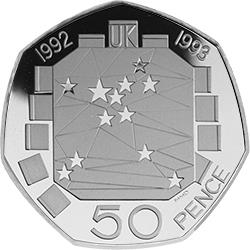
The same can be said of the 1989 Claim of Right £2, which was demonetized in 1997 when the bi-metallic £2 coin was introduced.
This coin has a mintage of 381,400 which makes it the rarest UK £2 and would put it in second place on the list if it were still in circulation.
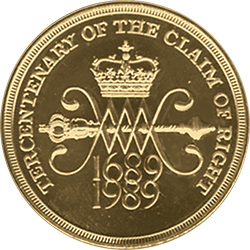
Are you lucky enough to have any of the top 10 rarest coins in your collection? Or perhaps you’ve even been lucky enough to get your hands on the pre-1997 coins listed above. Let us know in the comments below!
If you’re interested in coin collecting, our Change Checker web app is completely free to use and allows users to:
– Find and identify the coins in their pocket
– Collect and track the coins they have
– Swap their spare coins with other Change Checkers

Sign up today at: www.changechecker.org/app
New Pence Two Pence – how much is the 1983 2p worth?
When the UK switched to decimal coinage in 1971, it was decided that the word ‘new’ would be included in the denomination on some of our coins to avoid confusion between the new decimal coinage and the old currency.
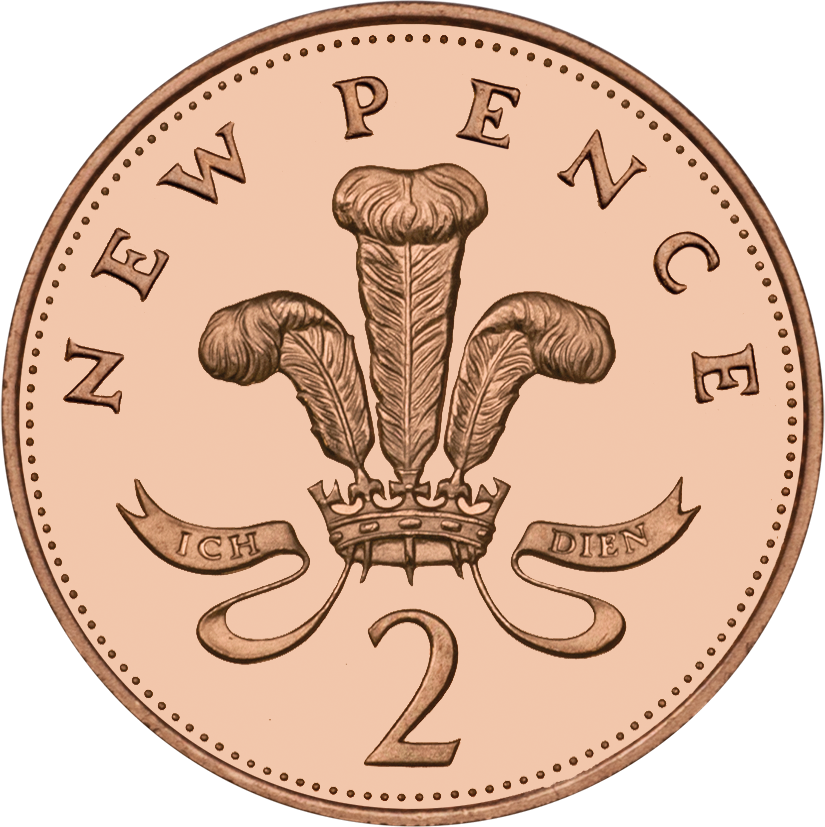
By 1982 the coins were no longer new so the word was dropped, and the 2p design changed from ‘New Pence’ to ‘Two Pence’.
A common misconception is that all ‘New Pence’ coins are rare, but in fact almost 1.5 billion of these coins were initially issued in 1971 and circulating mintage figures from decimalisation to 1981 (after which the design changed) are actually all in the hundreds of millions:
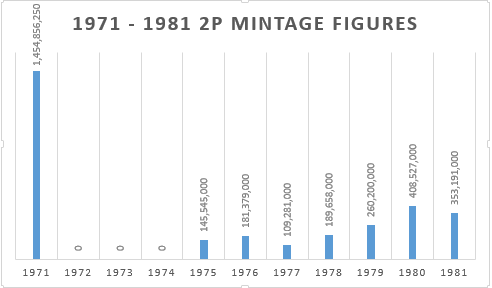
As you can see from the chart above, no 2p coins were issued for circulation between 1972 and 1974, so if you find one of these in your change it will actually be taken out of a Proof set, not intended for circulation.
1983 ‘New Pence’ Error 2p
After the design changed from ‘New Pence’ to ‘Two Pence’ in 1982, a mistake was made during production of a small number of 1983 coins…
These coins were actually struck with the old inscription – ‘New Pence’.
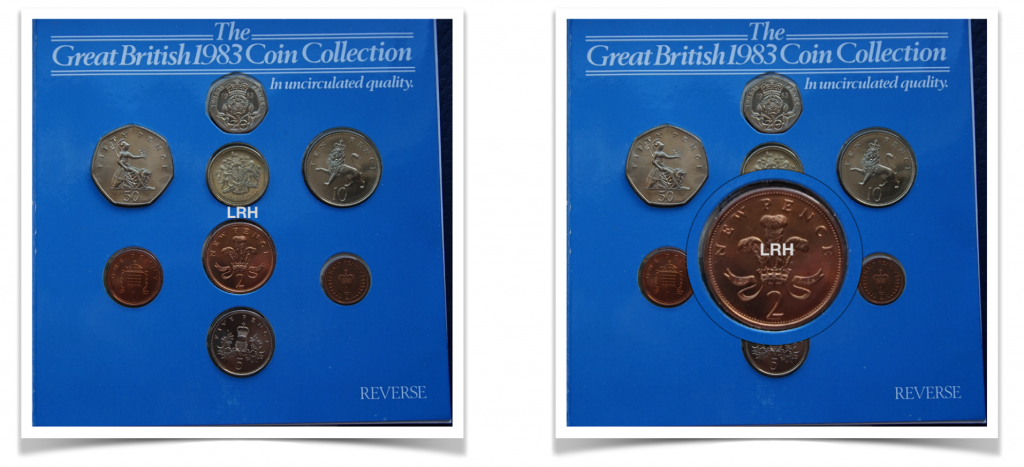
Whilst it’s not known exactly how many of these error coins were struck, in 1983 2p coins were only struck for commemorative sets and not issued for circulation. Evidence seems to suggest that affected coins were issued as part of special souvenir sets that also did not enter general circulation – although if these sets were broken open and spent then you could be in with the chance of finding one in your change…
How much is it worth?
If you’re lucky enough to find a 1983 ‘New Pence’ 2p in your change, not only does the rarity of this coin make it more collectable, but the coin was also struck in uncirculated quality – meaning it won’t have the scratches and blemishes of circulation coins.
This means a collector would most likely be willing to pay a little more to get hold of one on the secondary market.
The individual 1983 2p coin has been known to sell for £500 – £700, however the 1983 coin sets have been known to sell for over £1,000 on the secondary market!

If you do decide to look for this coin on the eBay and other secondary market sites, beware of fraudsters looking to pass off a ‘New Pence’ 2p from any other date as a rare coin.
The image below shows a 1971 2p coin listed for £2,000! Although this coin might be considered more collectable as it was the first UK 2p ever issued, this also means that nearly 1.5 billion 1971 2p coins were struck, making it the most common 2p coin issued.

Remember that it’s the 1983 version of the coin which was struck in error and this is the one you should be looking out for.
Have you ever come across a 1983 ‘New Pence’ 2p coin? Let us know in the comments below!
If you’re interested in coin collecting, our Change Checker web app is completely free to use and allows users to:
– Find and identify the coins in their pocket
– Collect and track the coins they have
– Swap their spare coins with other Change Checkers

Sign up today at: www.changechecker.org/app
August 2019 Scarcity Index update!
Discover how sought-after your coins are with the latest Scarcity Index update!
This information has been compiled using data from the Change Checker Swap Centre (find out how it works here) and presented in the easy to use indexes below, with arrows to signify how many places up or down a coin has moved since the last Scarcity Index.
A-Z 10p Scarcity Index

There has been quite a bit of movement on the A-Z 10p Scarcity Index since the last update, which is to be expected as more of these coins start turning up in people’s change and duplicates are swapped.
Moving up 7 places to take the top spot on the index is Z for Zebra Crossing, which is now the most sought-after A-Z 10p.
Amongst the top 4 scarcest coins on the index is the N for NHS 10p, which has also jumped up 7 places, although the biggest upward movement actually goes to A for Angel of the North. This coin has managed to move up the index by 12 places and now sits in the middle of the pack.
Conversely, the biggest downward movement goes to K for King Arthur (previously at the top of the index) which has now dropped by 21 places to sit amongst the bottom 5 coins.
It’s important to note that the A-Z 10p Scarcity Index is currently based on estimated mintage figures, assuming each coin has been struck in equal quantities. This includes the extra 2.1 million coins released in 2019. It will certainly be interesting to see what happens to the index once the official mintage figures are confirmed.
50p Scarcity Index

There’s no surprises at the top end of the 50p Scarcity Index, with the Kew Gardens remaining on top and the next top 5 coins remaining unchanged.
Whilst there has been some small movement amongst the Olympic 50ps, aside from the Kew Gardens, these coins dominate the top 17 places on the index.
In fact, the only non-Olympic 50ps to feature on the first half of the index are the Kew Gardens, Jemima Puddle-Duck, Sir Isaac Newton and Suffragettes 50ps, which remain in the same position as the last update.
The biggest upwards movement for the 50p index actually goes to Canoeing and the Battle of Hastings, both of which have moved up by 6 places.
The Battle of Hastings 50p was re-issued this year as part of the 50th Anniversary of the 50p Military Set, which might have increased demand for the circulation coin.
Both Fencing and Ironside 50ps have actually moved 8 places down the index since the last update, although it’s worth noting that Ironside moved up 9 places on the last index, so is mostly likely just settling back into place following increased popularity last quarter.
We’re eagerly waiting for when the mintage figures for 2018 coins will be released so that we can update the Scarcity Index and add some new coins into the mix!
£2 Scarcity Index

There’s been quite a shuffle on the £2 index this quarter and whilst the Commonwealth Games Northern Ireland £2 remains on top, the other Commonwealth Games coins have had a move around.
In fact, the Commonwealth Games Wales £2 has now been overtaken by Olympic Centenary and King James Bible which have managed to break up the Commonwealth Games coins by pushing Wales down to 6th place on the index.
The biggest increase goes to the Gunpowder Plot £2, which has moved up the index by 7 places to now sit nearer the middle of the pack.
Rugby World Cup has taken a big hit this quarter and has actually moved down 10 places to second from the bottom.
This has effectively bumped up the bottom few coins by one or two places each.
It will be really interesting to see how the £2 index will change in future if more £2 coins enter circulation and mix up the rankings.
How your Scarcity Index works
Generally collectors have had to rely upon mintage figures to identify the scarcest coins. But they only tell part of the story. Trying to find a good quality coin from 15 – 20 years ago, even for a higher mintage issue, is much more challenging than a more recent issue, as coins become damaged over time and are ultimately removed from circulation.
Additionally, some designs are more hoarded than others by people who might not normally collect coins – the poignant First World War £2 Coin series being an example. Finally, it can be up to a couple of years before the Royal Mint eventually confirms the actual mintage for an issue.
That’s why we have combined the mintage information with two other key pieces of information.
- How many of each design are listed as “collected” by Change Checkers, indicating the relative ease of finding a particular coin.
- The number of times a design has been requested as a swap over the previous 3 months, showing the current level of collector demand.
Importantly, as new coins are released and popularity rises and falls across different designs the Scarcity Index will be updated quarterly allowing Change Checkers to track the relative performance of the UK’s circulation coins.
How much are my coins worth?
The Scarcity Index does not necessarily equate to value but it is certainly an effective indicator. For example, the Kew Gardens 50p coin commands a premium of up to 200 times face value on eBay.
You can use the 6 point guide to help you determine a more realistic value for your coins.
What about £1 Coins?
The £1 Scarcity Index has already been published for the Round £1 coins and, because they are no longer being issued, this is now set in stone.
If you’re interested in coin collecting, our Change Checker web app is completely free to use and allows users to:
– Find and identify the coins in their pocket
– Collect and track the coins they have
– Swap their spare coins with other Change Checkers

Sign up today at: www.changechecker.org/app




